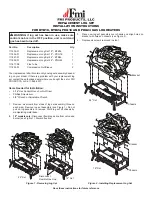
5
GB
Ceramic glass should
be disposed of as resid-
ual waste, together with
pottery and porcelain
CERAMIC GLASS
CANNOT BE
RECYCLED
Packaging Recycle
The packaging accompanying the product should be
recycled according to national regulations.
Door and Glass
Should there be any soot on the glass it may be
necessary to clean it.
Use dedicated glass cleaner,
as other detergents may damage the glass/gaskets.
(Attention! Be careful, even dedicated glass cleaner can
damage the varnish on the door frame and gaskets)
.
A good advice for cleaning the glass is to use a damp
cloth or kitchen roll paper and apply some ash from the
burn chamber. Rub around the ash on the glass and
finish off with a piece of clean and damp kitchen roll
paper. Attention! Only clean when the glass is cold.
Periodically, it may be necessary to change the gaskets
on the door to ensure that the burn chamber is air tight
and working optimally. These gaskets can be bought as
a set, usually including ceramic glue.
3. Advice on lighting a fire
Combustion pace
A heat storing product should not be burned in too
aggressively as this may damage the product. In
order to get the most out of a heat storing product, it is
therefore important to optimise the combustion pace
and the size of the loads. Read the combustion rates
and load sizes that apply to your product.
The best way to light a fire is with the use of lightening
briquettes and dry kindling wood. Newspapers
cause a lot of ashes and the ink is damaging for the
environment. Advertising flyers, magazines, milk
cartons and similar are not suitable for lighting a fire.
Good air supply is important at ignition. When the flue is
hot the draught increases and door can be closed.
Warning NEVER use a lighting fuel such as
petrol, kerosene, alcohol or similar for lighting
a fire. This could cause injury to you as well as
damaging the product.
Warning:
In order to avoid injuries, please be
aware that the surfaface may become hot during
operation and that extra care need to be taken to
avoid skin burn.
Use clean and dry wood with a maximum moisture
content of 20% and minimum 16%. Humid wood
requires a lot of air for the combustion, as extra energy/
heat is required for drying the humid wood and heat
effect is therefore minimal. In addition this creates soot
in the chimney with the risk of creosote and chimney
fire.
Storing of wood
In order to ensure that the wood is dry, the tree should
be cut in winter and then stored during the summer,
under roof and in a location with adequate ventilation.
The wood pile must never be covered by a tarpaulin
which is lying on the ground as the tarpaulin will then
act as a sealed lid that will prevent the wood from
drying. Always keep a small amount of wood indoors for
a few days before use so that moisture in the surface of
the wood can evaporate.
Burning
Not enough air to the combustion may cause the glass
to soot. Hence, supply the fire with air just after the
wood is added, so that the flames and gases in the
combustion chamber are properly burnt off. Open the
air vent and have the door slightly ajar in order for the
flames to establish properly on the wood.
Note that the air supply for the combustion also can
be too large and cause an uncontrollable fire that very
quickly heat up the whole combustion chamber to an
extremely high temperature (when burning with a closed
or nearly closed door). For this reason you should never
fill the combustion chamber completely with wood.
Lighting a fire
Kindling wood
Finely chopped (diameter of 3-5cm)
Length: <40cm
Ca. amount pr lighting : 2,3 kg
Place the air vent control in ignition mode - maximum
to the right. Set the damper in by-pass mode pulling the
lever out.
Insert small, dry pieces of wood, ignite and ensure the
flames have taken proper hold of the wood. When the
flames are stable and the chimney is warm, pull the air
control out of the ignition mode turning left, when click
sound is felt and heard, the ignition air is closed.
In case of a chimney fire, close the door and air
supplies on the stove / insert and call the Fire
Brigade. After a chimney fire the chimney must in
all cases be inspected by an authorized chimney
sweeper before you use the appliance again.
Warning!
The Firebox shall to be always closed except during
ignition, refueling and ash removal.
Содержание PN-SAL01-300
Страница 32: ...32 FIG 4 A B CO SAL01 02A CO SAL01 010 CO SAL01 010 1 A 1 B 2 A PI SAL01 010 PI SAL01 010 2 B...
Страница 34: ...34 PI SAL01 04A PI SAL01 04B FIG 6 PI SAL01 030 FIG 5...
Страница 36: ...36 FIG 8 A CO SAL01 020 CO SAL01 020 FIG 8 B CO SAL01 020 x4 A cryl x4 A cryl...
Страница 47: ...47 Salzburg L Convection Salzburg L Convection 1 extension FIG 24 a FIG 24 b...
Страница 51: ...51 8 mm FIG 30 A c r y l Acryl...
Страница 52: ...52 FIG 31 IS SAL02 040 FIG 32 CO SAL01 060 22 SAL01 180 x 2...
Страница 58: ...58 FIG 38d FIG 38c 10x6 LA SAL01 060...
Страница 59: ...59 FIG 40 FIG 39 LA SAL01 070...
Страница 60: ...60 FIG 41 FIG 42 LA SAL01 080 LA SAL01 090...
Страница 61: ...61 FIG 44 FIG 43 180 20 Q27FL 010 22 SAL01 170 22 SAL01 160 A cryl...
Страница 62: ...62 FIG 45 1 1 2 2...
Страница 66: ...66 FIG 52 Salzburg L Convection 1 2 FIG Z A cryl A c r y l...






































